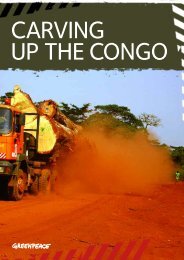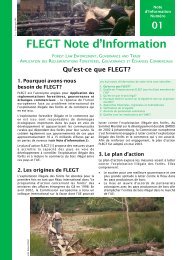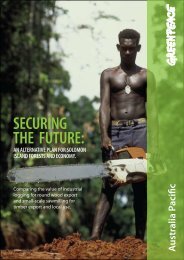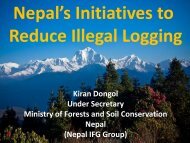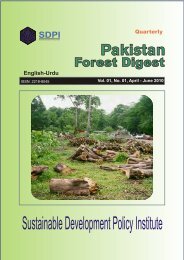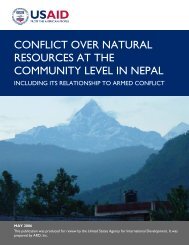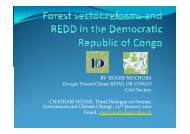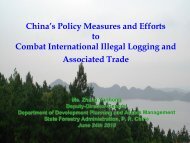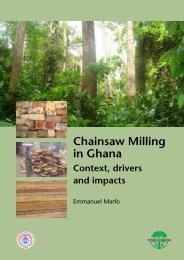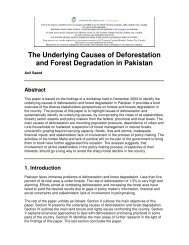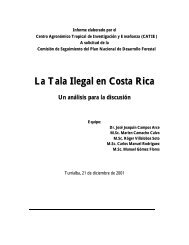download document - Rights and Resources Initiative
download document - Rights and Resources Initiative
download document - Rights and Resources Initiative
- No tags were found...
You also want an ePaper? Increase the reach of your titles
YUMPU automatically turns print PDFs into web optimized ePapers that Google loves.
Historical <strong>and</strong> contemporary l<strong>and</strong> laws <strong>and</strong> their impact on indigenous peoples’ l<strong>and</strong> rights in Ug<strong>and</strong>a:The case of the BatwaInter-American system of human rights has been in protecting the rights of indigenouspeoples. The African system could take a leaf from the Inter-American book, in an effort toengender progressive jurisprudence on the protection of indigenous peoples in Africa.The 1981 African Charter on Human <strong>and</strong> Peoples’ <strong>Rights</strong> promotes <strong>and</strong> protects the rights toequality <strong>and</strong> human dignity of all individuals, including individual members of indigenouscommunities. It also recognises collective rights of ‘peoples’. Unfortunately, this concept of‘peoples’ is not clear; neither is it certain that it can be used to pursue indigenous people’s l<strong>and</strong>rights. The African Commission encountered this concept in the case of Katangese Peoples’Congress v. Zaire, 129 but did not define it. It has been argued that the Commission has pavedthe way for the protection of indigenous peoples through the concept of ‘peoples’ rights’. 130At the international level, the United Nations (UN) General Assembly adopted in 1989 theConvention on the <strong>Rights</strong> of the Child. 131 Articles 29 <strong>and</strong> 30 of this Convention state thatchildren of minority or indigenous origin shall not be denied the right to their own culture,religion or language.The other equally important international instrument is the Convention on Biological Diversity(CBD), which Ug<strong>and</strong>a ratified in 1993. Decision VII. 28 (on Protected Areas) of the CBD’s 2004Seventh Conference of the Parties (COP7) enjoins the states parties to ensure full <strong>and</strong> effectiveparticipation of <strong>and</strong> full respect for the rights of indigenous <strong>and</strong> local communities in theestablishment, management <strong>and</strong> planning of protected areas, in line with Article 8(j) of theCBD. This should be consistent with national law <strong>and</strong> applicable international obligations. TheFPP, UOBDU <strong>and</strong> CARE review of Ug<strong>and</strong>a’s implementation of the CBD Programme of Workon Protected Areas observes that there have been no consultations with or participation on thepart of the indigenous Batwa in respect of such a process. 132The United Nations Declaration on the <strong>Rights</strong> of Indigenous Peoples (UNDRIP) notes the veryclose link between indigenous peoples controlling l<strong>and</strong> <strong>and</strong>/or territory, the enjoyment of otherrights, <strong>and</strong> development in accordance with their aspirations. 133 Denial of the Batwa’s right tooccupy their ancestral l<strong>and</strong> thus breaches an established norm in international human rightslaw, <strong>and</strong> leads to violation of a chain of rights guaranteed therein.The fact that the UNDRIP is a ‘Declaration’ weakens it’s enforceability within the jurisdictionsof its member states, since it provides for no enforcement mechanism at the international level.However, since it restates norms that are contained in other international human rightsinstruments, it is a key interpretive tool in resolving issues under specific instruments, say the129 Communication No. 75/92, 1995. Other cases by ‘peoples’ include Malawi African Association & others v.Mauritania, Communication Nos. 54/91, 61/91, 98/93, 164/97 à 196/97 <strong>and</strong> 210/98, 2000, where the blackpopulation of Mauritania accused the government of marginalising them, <strong>and</strong> filed a Communication to theCommission for violation of rights under the African Charter, including Articles 18 <strong>and</strong> 19.130 Bojosi <strong>and</strong> Wachira (2006), p 383.131 Adopted <strong>and</strong> opened for signature, ratification <strong>and</strong> accession by General Assembly resolution 44/25 of 20November 1989; entered into force 2 September 1990, in accordance with Article 49.132 FPP, UOBDU <strong>and</strong> CARE (2008), p 3.133 This can be inferred from Paragraph 9 of the Preamble to the UN Declaration on the <strong>Rights</strong> of IndigenousPeoples.Nakayi 28January 2009




